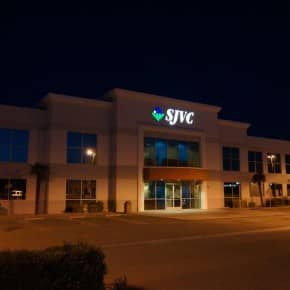Hesperia Lets it Shine for Autism
 Everywhere you look you see blue. The Hesperia campus lobby and other common areas were illuminated with blue, many students were dressed in blue and message boards contained blue bulletins about “Light it Up Blue”, “Shining a light on Autism” to raise awareness for this world-wide event. The Empire State Building, the Sydney Opera house in Australia and the Leaning Tower of Pisa join hundreds of famous buildings and landmarks across many countries to share bright blue support for the national organization, Autism Speaks.
Everywhere you look you see blue. The Hesperia campus lobby and other common areas were illuminated with blue, many students were dressed in blue and message boards contained blue bulletins about “Light it Up Blue”, “Shining a light on Autism” to raise awareness for this world-wide event. The Empire State Building, the Sydney Opera house in Australia and the Leaning Tower of Pisa join hundreds of famous buildings and landmarks across many countries to share bright blue support for the national organization, Autism Speaks.
SJVC Diversity Committee members, Lauren Brown (Financial Aid Officer) and Misty Christensen (Dean of Students) felt it important to help educate students about this neurological disorder that affects so many children and impacts families everywhere. “We wanted to educate our students about autism because it is a disorder that makes those with it feel different from others and, especially since so many of our students are in medical programs, they should know more about this,” says Lauren Brown.
Lauren’s 13-year old son, Brendon, has autism on the moderate-severe spectrum and has sensory processing disorder that causes him to shy away from social interaction with others. “I felt it was important for students and staff to understand that autism is not a noticeable disability and often takes a psychologist, specialist and pediatrician, along with a battery of assessments, to diagnose autism,” says Lauren, whose son was not diagnosed until he was 6-years old.
“Everyone knows someone who is either directly or indirectly affected by this,” says Lauren. “When we were getting ready to do this event we found staff and students who had a child affected by autism,” she says. Most had few resources for their child and struggled to find support for families and appropriate therapy and education options.
Autism spectrum disorder includes Asperger’s syndrome and presents a broad scale of behavior and sensitivity severity. Misty Christensen’s 5-year old son, McAllister, has Asperger’s syndrome, “called the Little Professor’s disease,” she offers. “McAllister is high-functioning and very intelligent,” says Misty, “but has some social deficiencies.” McAllister exhibits a sensory processing disorder that makes the touch of some clothing, such as jeans, on his skin unbearable. “It’s hard for them (with Asperger’s) to know where their bodies are in space,” says Misty, whose son sometimes feels like things are crawling all over his body. It helps for McAllister to wear weighted vests to better orient his physical body.
Children with autism or Asperger’s Syndrome may:
- Be overly sensitive in sight, hearing, touch, smell, or taste (for example, they may refuse to wear “itchy” clothes and become distressed if they are forced to wear the clothes)
- Have unusual distress when routines are changed
- Perform repeated body movements
- Show unusual attachments to objects
Communication and social interaction problems may vary from moderate to severe.
The Hesperia campus provided students with a PowerPoint presentation to educate them about autism and the importance of awareness. Throughout April the campus held fundraisers, dress-down days, and raffles and sold blue cotton candy to raise money for Autism Speaks.
One percent of the U.S. population, age 3-17, has an autism spectrum disorder. Other important statistics:
- Autism affects 1 in 88 children and 1 in 54 boys (Boys are 5 times more likely than girls to have autism)
- Autism is the fastest-growing developmental disability in the U.S.
- Autism cost a family an average of $60,000 a year to manage treatment
- Autism receives less than 5% of the research funding given less prevalent childhood diseases
- There is no medical detection or cure for autism
Misty Christensen’s son’s occupational therapist said, “Autism is a spectrum, and everybody is on it somewhere.”
“This event left a huge impression on our staff, faculty and students,” says Lauren Brown. And, those who came forward with their personal stories of struggle with this disorder within their own families were glad to see their campus become a part of autism awareness.
There is so little support and few resources within local communities for families of children with autism or Asperger’s. Misty, who says at 18-months old, McAllister lay down for a nap and woke up with severe behavior changes “as though a light switch was flipped,” has struggled to find help. “It was really, really hard,” she says. “We are so underserviced in our area.”
The Hesperia campus can be part of bringing autism awareness, not only to students, staff and faculty, but to their community. “Our people here who have children with autism and Asperger’s can be the change that brings the resources to their children and this area,” says Lauren Smith.
For more information about autism spectrum disorder visit autismspeaks.org.
More stories about
Request Information
All fields using an asterik (*) are required.